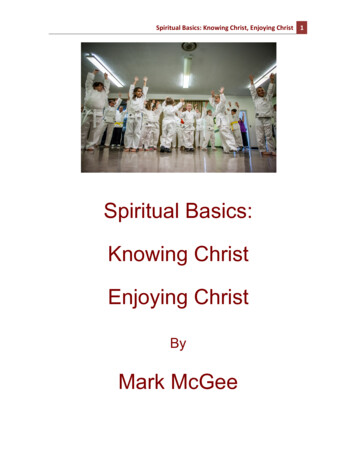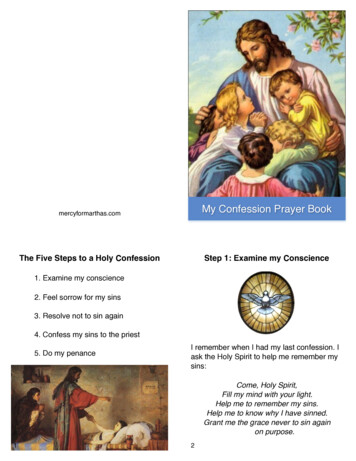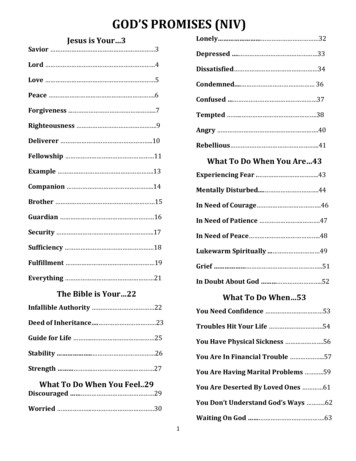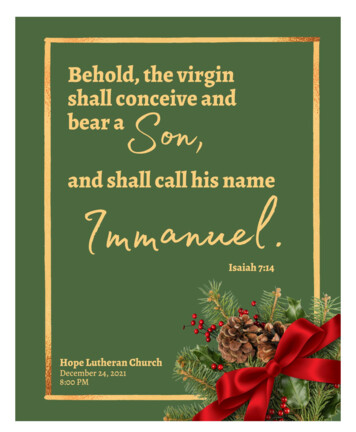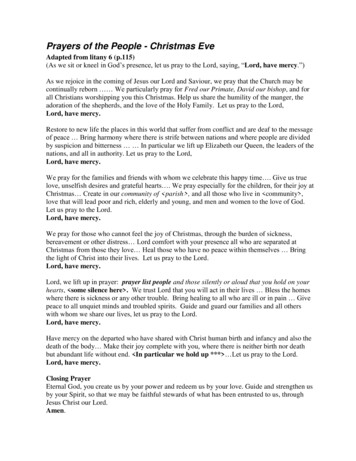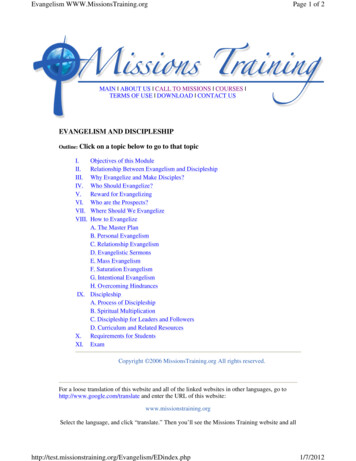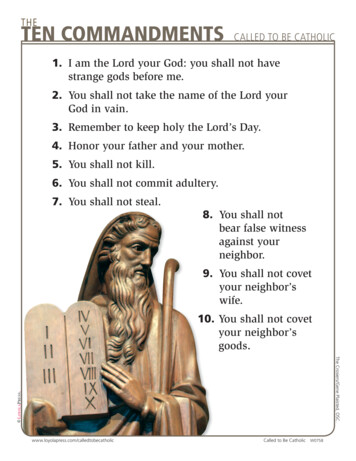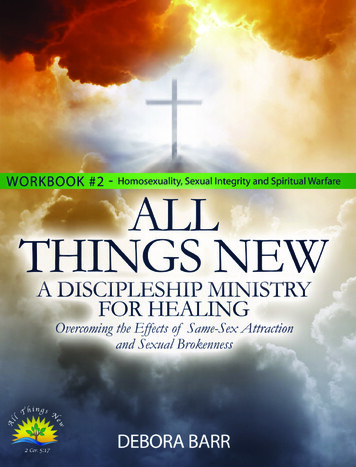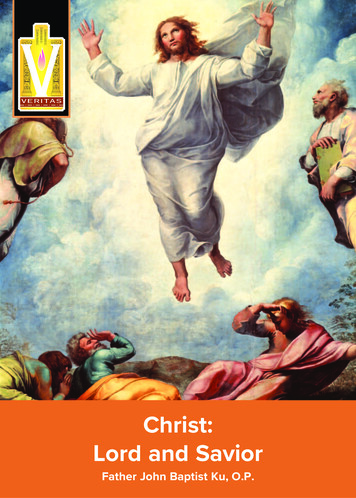
Transcription
VVERITASChrist:Lord and SaviorFather John Baptist Ku, O.P.
The Veritas Series is dedicated to Blessed Michael McGivney(1852-1890), priest of Jesus Christ and founder of theKnights of Columbus.
The Knights of Columbus presentsThe Veritas Series“Proclaiming the Faith in the Third Millennium”Christ:Lord and SaviorbyFATHER JOHN BAPTIST KU, O.P.General EditorReverend Gabriel B. O’Donnell, O.P.Catholic Information ServiceKnights of Columbus Supreme Council
Nihil ObstatMost Reverend Robert J. McManus, D.D., S.T.D.Censor DeputatusImprimaturRobert E. Mulvee, D.D., J.C.D.Bishop of ProvidenceNovember 1, 2002The Nihil Obstat and Imprimatur are official declarations that a book or pamphlet is freeof doctrinal or moral error. No implication is contained therein that those who havegranted the Nihil Obstat and Imprimatur agree with the contents, opinions, or statementsexpressed.Copyright 2002-2021 by Knights of Columbus Supreme Council. All rights reserved.Citations from the Catechism of the Catholic Church are taken from the Catechism of theCatholic Church for the United States of America, copyright 1994 by the UnitedStates Catholic Conference, Inc., Libreria Editrice Vaticana. All rights reserved.Scriptural quotations are taken from The New Oxford Annotated Bible With the Apocrypha(Expanded Edition), Revised Standard Version copyright 1973, 1977, Oxford UniversityPress. Some citations have been adapted.Cover: Raphael (1483-1520), The Transfiguration (detail), Pinacoteca, Vatican Museums,Vatican City State Scala/Art Resource, New York.No part of this book may be reproduced or transmitted in any form or by any means,electronic or mechanical, including photocopying, recording, or by information storageand retrieval system, without permission in writing from the publisher. Write:Catholic Information ServiceKnights of Columbus Supreme CouncilPO Box 1971New Haven CT 800-735-4605 faxPrinted in the United States of America
CONTENTSINTRODUCTION .5I.WHO IS JESUS CHRIST?.6Heresies and the Development of Doctrine .7Jesus Reveals the Father and the Holy Spirit.14II. HOW DO WE KNOW ABOUT JESUS CHRIST? .17Problem vs. Mystery .17Witnesses to Christ: Scripture, Tradition,and the Church.19The Church Christ Founded.20III. HOW DO WE MEET CHRIST? .22The Way of Transformation in Christ.24The Visible Church .25The Liturgy and Sacraments.26Sacred Scripture .28Charity.29Ascetism .30“THE TRUTH WILL SET YOU FREE” .32FOR FURTHER READING .35ABOUT THE AUTHOR .36-3-
-4-
CHRIST:LORD AND SAVIORINTRODUCTIONThere is salvation in no one else, for there is noother name under heaven given among men bywhich we must be saved (Acts 4:12).The Catholic Church confesses that Jesus Christ, the man born 2,000years ago in Bethlehem, is himself the eternal Son of God and theonly Savior of mankind. Our belief depends not on natural humaninvestigation but on God’s own words and promises, the faith oncedelivered to the saints (Jude 1:3). The words above, taken from the NewTestament, express the solemn praise bursting forth in the hearts ofall who have come into contact with the living Christ and have beenfreed from sin and death. Christians cry out: “Jesus is Lord! King ofKings! Lord of Lords! The Son of the living God!” What do we meanby these titles and praises? How can a man, born in time, be theeternal Son of God? In this booklet we will consider who Christ is,how the Church knows him, and why we speak of him as we do.This booklet is divided into three parts. Taken together, these serve asan introduction to the Catholic Church’s faith concerning Jesus Christ.I. WHO IS JESUS CHRIST?II. HOW DO WE KNOW ABOUT CHRIST?III. HOW DO WE MEET CHRIST?-5-
I. WHO IS JESUS CHRIST?From the Bible we know that Jesus’ mother was the virgin Mary andthat his foster father was Joseph the carpenter (Matthew 1:18–20,13:55; Luke 1:26–35, 3:23). Jesus too was a carpenter (Mark 6:3).James, Joseph, Simon and Jude were close relatives, perhaps cousins(Matthew 13:55).1 Jesus, a speaker of Aramaic, could read the OldTestament in its original Hebrew (Luke 4:18).The public ministry of Jesus began after his baptism by his cousinJohn the Baptist (Luke 3:21–23, 36). Jesus taught in synagogues andin the streets; he debated with scribes and other experts in the JewishLaw (that is, the religion and words of the Old Testament). Hegathered disciples, worked miracles, expelled demons, healed thesick, and announced the coming of the reign of God. Jesus associatedwith sinners, something which brought sharp disapproval from thescribes and Pharisees.The Gospels suggest that the public ministry of Jesus lasted threeyears. Since Jesus, when he began his ministry, was about thirty years ofage (Luke 3:23), Christians estimate that he was crucified around agethirty-three. Hated by the scribes and Pharisees for his popularity,for exposing their hypocrisy, and for claiming to be the Son of God,Jesus was put to death when his enemies convinced the Romangovernor of Judea, Pontius Pilate, that Jesus was a threat to theRoman Empire.After three days in the tomb, Jesus rose from the dead and appearedfirst to Mary Magdalene and then to his apostles and disciples (cf.Matthew 28:1–10, Mark 16:9–18, John 20:1–30, 1 Corinthians15:5–8). After forty days spent teaching them (Acts 1:3), Heascended to heaven (cf. Matthew 28:16–20, Mark 16:19, Luke 24:51,Acts 1:9–11).-6-
Heresies and the Development of DoctrineThe facts about Jesus’ life would be of little interest were he not theChrist, the Savior of the world, God Himself appearing in human flesh.The key assertion we Catholics make about Christ is that he is “trulyGod and truly man.” He is not a mixture of divinity and humanity,or “somewhat divine” and “somewhat human.” Rather, the one andonly Son and Word of God, who is truly and completely God fromall eternity, has become one of us—true man, born of the VirginMary. Christ is complete and perfect in his divinity as the EternalSon of the Father, and he is complete and perfect in his humanity, inthe manhood he took to himself for our sake. The divinity andhumanity of Christ are so knit together that they are inseparable;they are perfectly united, and this union of divinity and manhood isthe cause of our salvation.There are basically two ways to go wrong in speaking about whoChrist is: one can deny his full divinity or one can deny his fullhumanity. The easiest way to grasp what the Church believes is totrace the history of the heresies that have confronted her over thecenturies. By wrestling with questions and controversies, the Churchhas steadily clarified her teaching and has developed very accurateand careful ways of speaking about the mystery of the incarnation—that is, about how Jesus is truly God and truly man.Heresies—deviations from the truth of the Catholic faith—arise notonly out of malice or mischief. Often enough, heresies begin withinnocent mistakes and well-intentioned but misguided judgments.In testing or pursuing an idea that, at first, may seem entirely faithfuland reasonable, one can inadvertently wander off the path of soundfaith. Typically, heresies emerge when believers emphasize just oneaspect of a teaching to the detriment of the whole truth. Making aninnocent mistake is not heresy in the strict or formal sense—strictlyspeaking, heresy only occurs when a Christian stubbornly clings toan error, despite the Church’s correction and teaching to the contrary.-7-
In Christology—the area of doctrine concerning Christ—heresies andvarious inadequate ideas have given the Church reason to articulatewhat she believes about Jesus Christ more specifically and clearly.The main questions about the human and divine natures of Christemerged in the first 500 years of Christian history. Debate was mostheated for the two centuries between roughly A.D. 275 and A.D. 475.In this period, a series of Ecumenical (“Universal”) Councils wereheld by the Popes and bishops to resolve controversies and defendthe Church’s faith against error.Among early heresies, we can recognize a whole family of mistakesthat deny Christ’s true humanity.Perhaps the simplest form in this family was the heresy calleddocetism—named from the Greek verb “dokeo,” meaning “to seem.”The docetists were of the opinion that Christ only seemed to have abody, only seemed to suffer, and only seemed to die. In reality, thedocetists said, Jesus was only an apparition or an illusion, and not aphysical being. Docetism was motivated by a desire to affirm thedivinity of Christ—the docetists were, in effect, afraid that byadmitting to Christ’s real body and real suffering they would be leftunable to maintain that he is divine. The Church certainly neededto maintain faith in Christ’s divinity, but she recognized that it wouldbe a great mistake to argue this point by denying his humanity! Thisearly crisis led the Church to see that she had to affirm both thedivinity and humanity of Christ at the same time.Closely related to docetism was the more complicated (andinfluential) heresy called gnosticism. (Gnosticism gets its name fromthe Greek word gnosis, meaning knowledge.) Gnostics did not all agreewith each other, but on the whole they did agree that the saving workof Christ was mainly a work of enlightenment—that is, of impartingsecret knowledge (gnosis). This secret enlightenment, it was supposed,would purify and lift the mind up to a divine life. The body, however,was to be despised and abandoned. Now while God does enlighten-8-
us with a knowledge of himself, the gnostic movement effectivelydenied the importance of Christ’s (and our own) physical humanity.The suffering and death of Christ, certainly, had no useful place inthe gnostic scheme. Moreover, gnosticism tended to reinterpret thesacraments as “merely symbolic actions” (instead of really effectiveones), to reduce the Church to “the enlightened” (i.e., the gnosticcliques), setting up in place of bishops a curious elite judged superiorfor their possession of secret knowledge. Naturally, the Church hadlittle patience with gnosticism—Christ had come, after all, not foran elite group of “insiders” but for all. Moreover, he did not want hisfollowers to keep his teachings secret, but to preach them to the endsof the earth. Finally, it was important for the Church to hold fast tothe fact that we are saved through incorporation into Christ—achange that involves the conversion and transformation of one’s wholelife and character. Salvation is not only about knowledge.A third heresy in this family, non-Christian in origin, wasManichaeism, named for its founder Mani. The Manichaeansimagined there were two gods, one good and the other evil. The evilgod, they thought, was responsible for the creation of matter and forthe “imprisonment” of souls within bodies. Thus the Manichaeans,amidst many other mistakes, dismissed the suggestion that God(the good god) could save us by sending Christ in the flesh to sufferand die. Since they considered matter and bodies evil, they had littleinterest in doctrines about Christ’s real humanity, his death, or hisresurrection. While Christians appreciated that the soul and spiritualthings are more important than material concerns, they saw that theManichaean solution was sacrificing the whole truth in overemphasizing just one aspect.None of these heresies proved as dangerous or divisive for the Churchas did Arianism, the heresy authored by a priest named Arius (A.D.250–336). The teachings of Arius were rather sophisticated. Heclaimed that Christ was “divine,” but not quite so divine as God theFather. The Son, he taught, was a creature who was neither eternal-9-
nor the “true God.” (The point which Arius exaggerated here is thatChrist has his origin in God the Father.) Besides denying Christ’s trueand full divinity, Arius also claimed that Christ had no human soul;he argued instead that Christ’s human body, though real, wasanimated by a semi-divine spirit and that Christ lacked a human mindand will. Arius’ guiding principle, however, was that only the Fatherwas really God (since only the Father is not “from” anyone else).In response to the Arian crisis, a meeting of bishops from throughoutthe Church was held in Nicea (modern northwest Turkey) in A.D.325. This first Ecumenical Council affirmed that Christ is truly andperfectly divine, even though he is “from the Father”—indeed,precisely because he is “from the Father.” The bishops at Niceacomposed a creed, a precisely articulated expression of the Church’sfaith, which is the basis of the creed all Catholics still sing or recitewhen celebrating the Holy Eucharist. The Nicene Creed confessesbelief in God the Almighty Father and “in our one Lord Jesus Christthe Son of God, the only-begotten born of the Father, that is, of thesubstance of the Father, God of God, light of light, true God of trueGod, born, not made .” Here we can see the clear affirmation of theSon’s equality with the Father—the Son is not a lesser God or acreature. Jesus, the Son, is “of the same substance of the Father.”Jesus, the Son, is “God from God, light from light, true God fromtrue God.” The Son is not less than the Father and was not created intime. The Son was “begotten, not made”—that is, he originates fromthe Father, but is not a creature (separate from the Father’s substance).After the Council of Nicea rejected Arianism, a bishop namedApollinaris (A.D. 310-390) erred in the opposite direction by denyingChrist’s true and perfect humanity. Although Apollinaris thoughtChrist must have had an “animal soul” to enliven his body, he heldthat for the incarnation to take place the eternal Son of God musthave taken the place of the human soul of Jesus. Apollinarianismwas rejected as heretical by the second Ecumenical Council, namely theFirst Council of Constantinople, in A.D. 381. In opposing Apollinaris,- 10 -
the Church insisted that the Son of God really had become a trueman—Christ was not just God using a body.An exceptionally important fifth century heresy was eventually calledNestorianism, acquiring its name from Nestorius, Patriarch (Bishop)of Constantinople, who was its most famous proponent. Nestoriuswanted to affirm that Christ is both God and man, but found himselfconfused by questions about the unity of these two natures.Trouble began when Nestorius rejected the title Theotokos (GodBearer or Mother of God), which Christians traditionally ascribe tothe Virgin Mary. Nestorius would admit that Christ is God, and thatMary is Christ’s mother, but he found himself uneasy with the titleTheotokos. Nestorius resisted because he thought that calling Mary“Mother of God” suggested that the Son of God did not exist beforebeing born of Mary, or that somehow the Son’s existence as eternalGod depended on her.As an alternative, Nestorius proposed the title Christotokos, “Motherof Christ,” stressing that Mary only became the Son’s mother intime—that is, when the Son became man. Unfortunately, theNestorian approach treats “Christ” and “God the Son” as twodifferent persons (one born of Mary, the other not). Since Christ istruly God, it is impossible to say that Mary gave birth to Christwithout giving birth to God. To avoid Nestorius’ confusion, we needonly recall that Christ is eternally God, the Son of the Father, whilehe became Mary’s son only in time. Since Christ remains forever trueGod and true man, Mary is rightly called “Theotokos”—for she borethe one, permanent person, God the Son, who became man in herwomb. Nestorianism was condemned at the Ecumenical Council ofEphesus (in modern Turkey) in A.D. 431. This was the thirdecumenical council in the Church’s history.Close on the heels of Nestorius came another opinion, commonlycalled monophysitism and associated with the abbot Eutyches.Eutyches refused to speak of “two natures” in Christ, though at the- 11 -
same time he seems to have wanted to affirm that Christ was trueGod and true man. Condemned along with Eutyches were a numberof bishops who held to a doctrinal formula composed many yearsearlier by Saint Cyril of Alexandria. Tarred as “monophysites” (not aname they accepted!), these bishops and theologians argued that inthe Incarnation two natures, human and divine, were combined andunited in such a way that they could no longer be spoken of as two.Thus they spoke of “one nature after the Incarnation” (mia physis, inGreek)—the unique nature of the Incarnate Word—and refused thecreed adopted by the larger Church.The view of Eutyches and the “monophysites” was rejected at theEcumenical Council of Chalcedon in A.D. 451.2 At this Council, thisChurch articulated her most ample confession of faith concerning thereality of the Incarnation.Following the holy Fathers, we unanimously teach and confessone and the same Son, our Lord Jesus Christ: the same perfectin divinity and perfect in humanity, the same truly God andtruly man, composed of rational soul and body; consubstantialwith the Father as to his divinity and consubstantial with usas to his humanity; “like us in all things but sin.” He wasbegotten from the Father before all ages as to his divinity andin these last days, for us and for our salvation, was born as tohis humanity of the Virgin Mary, the Mother of God.We confess that one and the same Christ, Lord, and onlybegotten Son, is to be acknowledged in two natures withoutconfusion, change, division, or separation. The distinctionbetween the natures was never abolished by their union, butrather the character proper to each of the two natures waspreserved as they came together in one person (prosopon) andone hypostasis.3Finally, after the Council of Chalcedon, the Second EcumenicalCouncil of Constantinople met in A.D. 553 and (among other projects)- 12 -
tried to extend the olive branch to the “monophysite” Churches. Toemphasize the reality of the union of divinity and humanity in Christ,Constantinople II expressly confirmed that Jesus Christ is the SecondPerson of the Holy Trinity—he is not merely the “embodiment” ofthe Eternal Son. As the Catechism of the Catholic Church (CCC)explains, this means that “everything in Christ’s human nature is tobe attributed to his divine person as its proper subject, not only hismiracles but also his sufferings and even his death: ‘He who wascrucified in the flesh, our Lord Jesus Christ, is true God, Lord of glory,and one of the Holy Trinity’” (CCC n. 468).The twists and turns of this early history are not easy to follow,especially since modern readers may not see the importance of all thefine points which the Ecumenical Councils needed to make. We cansummarize the importance of this history by stressing that:1. Jesus is a real, physical man: not an angel or a personwho only appeared to be born, to suffer, die, and rise from thedead. (No Docetism!)2. Jesus saves us, body and soul: physical reality, his andours, is inseparable from “spiritual” salvation. Thus theChurch, sacraments, bodily resurrection, and all of earthlylife are intimately part of Christ’s saving work. (No gnosticism,no Manichaeism!)3. The Son of God is truly God, equal to the Father indivinity. (No Arianism!)4. Jesus has a human soul—he is not just God using abody. (No Apollinarianism!)5. Christ our God is one individual, truly God and trulyman—there is no person “Jesus” except the Second Personof the Holy Trinity; in the Incarnation humanity anddivinity are truly united, yet neither nature is compromised.(No Nestorianism or monophysitism!)- 13 -
Jesus Reveals the Father and the Holy SpiritWithout the coming of Jesus Christ, we would not know about theHoly Trinity.Of all Christian teachings, the doctrine of the Trinity is the mostmysterious and the hardest to understand. As Saint Augustine said,while there is no subject more dangerous or difficult, there is also nosubject where finding the truth is more precious.4Jesus reveals that God is not solitary. On the contrary, the divine lifeis a life of three eternal divine persons who live in a perfectcommunion of love, knowledge, and glory. These three persons areGod the Father, God the Son, and God the Holy Spirit.Jesus identifies himself as the eternal Son of God, and explains thathe comes from the Father (John 16:28). He says also that the Fatherand the Son will send the Holy Spirit (John 15:26).One of the more revealing titles given to Christ in Holy Scripture isthe name “Word:” In the beginning was the Word, and the Word was withGod, and the Word was God . And the Word became flesh and dweltamong us, full of grace and truth; and we have seen his glory, the glory as ofthe only Son from the Father (John 1:1, 14). (See also Revelation 19:13.)Why is the Son of God called the Word? A word, of course, is anexpression of something in the mind of the person speaking. Whenwe human beings speak, we reveal our minds. It is extremelysatisfying when we can express ourselves completely and forcefully,especially when we are uttering a deep conviction or are putting intowords a strong feeling of love, anger, or sorrow. By contrast, if wecannot make ourselves understood, it can be bitterly frustrating.Upon reflection, we can appreciate that when God the Father speakseternally from his own depths, his “Word” is perfect, complete, andutterly expressive of himself. This is why the name “Word” is appliedto the Second Person of the Trinity, that is, to God the Son. The Son,who became man, our Lord Jesus Christ, is the perfect image and- 14 -
manifestation of the Father. Christ, the Eternal Son, is the image of theinvisible God (Colossians 1:15, cf. 2 Corinthians 4:4), who reflects theglory of God and bears the very stamp of his nature (Heb 1:3). This is why,when the apostle Saint Philip asked Jesus to reveal God the Father,Christ replied, Have I been with you so long, and yet you do not know me,Philip? He who has seen me has seen the Father; how can you say, ‘Show usthe Father’? (John 14:9).Besides revealing the Father to us (that is, by revealing that the Godof Israel is a Father, and not just a solitary person), Jesus also madeknown to us the Third Person of the Holy Trinity, namely the HolySpirit.This name, “Holy Spirit,” itself is not especially revealing, since boththe Father and the Son are certainly holy and spiritual. Nevertheless,it is fitting that this Person’s name be, so to speak, inconspicuous—for the Third Person of the Trinity does not draw attention to himself;rather he is the gift given to make God’s Word known. As theCatechism puts it,Now God’s Spirit, who reveals God, makes known to usChrist, his Word, his living Utterance, but the Spirit doesnot speak of himself. The Spirit who “has spoken throughthe prophets” makes us hear the Father’s Word, but we donot hear the Spirit himself. We know him only in themovement by which he reveals the Word to us and disposesus to welcome him in faith. The Spirit of truth who “unveils”Christ to us “will not speak on his own” {John 16:13}. Suchproperly divine self-effacement explains why “the worldcannot receive [him], because it neither sees him nor knowshim,” while those who believe in Christ know the Spiritbecause he dwells with them {John 14:17}.5In Scripture, we learn that it is the Holy Spirit who brought about theconception of Jesus in the womb of the Virgin Mary (cf. Matthew 1:20,Luke 1:35). So too, it is the Spirit who is sent to make Christ present- 15 -
to us and to incorporate us into Christ’s living body, the Church. Onlyby the active power of the Holy Spirit can we believe, pray, and enterinto the communion of the Trinity. As Saint Basil the Great said,Through the Holy Spirit we are restored to paradise, led backto the Kingdom of heaven, and adopted as children, givenconfidence to call God “Father” and to share in Christ’s grace,called children of light and given a share in eternal glory.6Jesus Christ did not completely reveal the Holy Spirit to us until theday of Pentecost, when—after his death and resurrection—he bestowedthe Spirit on the apostles gathered in prayer with the Virgin Mary (seeActs 1:14–2:4). According to Christ’s promise, it is the Holy Spirit, sentto us by the Father because of Christ, who confirms the Church in herknowledge of the truth (cf. John 14:16–17, 25–26) and who enrichesus with every spiritual gift (cf. Galatians 5:22–23, Isaiah 11:1–2).“God is love” and love is his first gift, containing all others.“God’s love has been poured into our hearts through theHoly Spirit who has been given to us.”7Because this divine love is a gift, and not something we can acquireon our own, we confess our need to receive it from Almighty God.Indeed, the good news of the Gospel is that God himself wants tobestow the Spirit on us, and to bring us into the everlastingcommunion of his own divine life. All that the Eternal Son enjoysby nature—the perfection of life and love in communion with theFather—we are called to enjoy by grace. It is for this that Christcame, died, rose, and bestowed the Spirit.One can hardly overemphasize the fact that Christianity alone, of allmajor religions and philosophies, claims that God became man sothat man might share in the life of God. Because of Christ,Christianity promises permanent, personal, “face to face” communionwith the Triune God. Even the great monotheistic faiths of Judaismand Islam do not promise such full personal communion with God—and much less the Eastern religions of Buddhism and Hinduism.- 16 -
Thus while Christians acknowledge that the saving power of Godmay extend to those who are ignorant of Christ, we must affirm thatit is through Christ alone that the gift of salvation is won andbestowed. There is, as Scripture says, no other name by which we are tobe saved (cf. Acts 4:12); and as no other religion claims to offer sucha salvation, it should not be surprising that Christians recognize Jesusas the only savior.There is only one salvific economy of the One and TriuneGod, realized in the mystery of the incarnation, death, andresurrection of the Son of God, actualized with thecooperation of the Holy Spirit, and extended in its salvificvalue to all humanity and to the entire universe: “No one,therefore, can enter into communion with God exceptthrough Christ, by the working of the Holy Spirit.”8While there may be many religious teachers in the world, and manyideas about the purpose of religion, those who believe that man ismade for eternal, personal communion with God (Father, Son, andHoly Spirit) confess that only God himself can give us this gift. Tosay this is not to prejudge those who have not received the Gospel,or to deny that the power of Christ is at work throughout the wholefamily of man, and indeed the whole cosmos. Our burning concern,rather, is to confess that Jesus is indeed the only Lord and Savior. Heis not “one more” religious leader among many, nor is the Catholicfaith “one more” religion. To admit Christ at all is to admit him onhis own terms, as uniquely the way, the truth and the life (John 14:6).- 17 -
II. HOW DO WE KNOW ABOUT CHRIST?Problem vs. MysteryIn thinking about Jesus Christ, it is critical that we appreciate thedifference between a mystery and a problem. Problems are difficulties tobe solved; mysteries are truths to be embraced in loving contemplation.A problem describes an unresolved situation which can be resolved byfurther investigation. Problems remain unsolved because of theircomplexity, not because they are intrinsically unsolvable. They couldbe solved if we had the time, intelligence and sufficient information.For instance, if your car or computer does not start or functionproperly, this is a problem to be solved—not a mystery to becontemplated! Even if the best technicians cannot offer a satisfactoryremedy, what we face is an unsolved problem.Mysteries, on the other hand, cannot be—and are not waiting to be—solved.9 They exceed human powers of discovery and description, andare not subject to experimentation or to man’s empirical scrutiny.Because the coming of the Son of God as man is a mystery, the Churchis not waiting for a brilliant theologian to come along and explain it.This mystery, like the mystery of the Holy Trinity, is something wecan contemplate and appreciate, but it is not a matter that we canaccount for in terms of all its causes and effects. Unlike internalcombustion engines and various physical phenomena, mysteries do notyield to disassembly, demonstration, or mathematical description.The reason mysteries defy rational comprehension is not that theyare illogical or self-contradictory. Rather, mysteries are obscure to usbecause our minds are limited by nature (and by the darkness andconfusion introduced by sin). In itself a mystery of faith is simply toovast and too bright to be taken in by our limited mental vision. AsSaint Thomas Aquinas put it, when we look at God’s mysteries weare like night-owls seeing the sun—our sight fails not because ofdarkness, but because the light is more than we can take in.- 18 -
That Christian teachings about Christ are mysterious in this sense shouldcome as no surprise. Indeed, it would be ra
Jesus was put to death when his enemies convinced the Roman governor of Judea, Pontius Pilate, that Jesus was a threat to the Roman Empire. After three days in the tomb, Jesus rose from the dead and appeared first to Mary Magdalene and then to his apostles and disciples (cf. M
